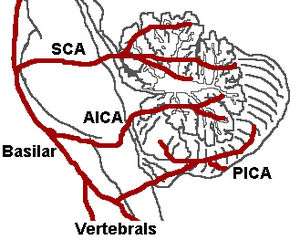Cerebellar stroke syndrome
Cerebellar stroke syndrome is a condition in which the circulation to the cerebellum is impaired due to a lesion of the superior cerebellar artery, anterior inferior cerebellar artery or the posterior inferior cerebellar artery.[1]
| Cerebellar stroke syndrome | |
|---|---|
 | |
| The three major arteries of the cerebellum: the SCA, AICA, and PICA | |
| Specialty | Neurology |
Cardinal signs include vertigo, headache, vomiting, and ataxia.[2]
Cerebellar strokes account for only 2-3% of the 600,000 strokes that occur each year in the United States.[3] They are far less common than strokes which occur in the cerebral hemispheres. In recent years mortality rates have decreased due to advancements in health care which include earlier diagnosis through MRI and CT scanning.[4] Advancements have also been made which allow earlier management for common complications of cerebellar stroke such as brainstem compression and hydrocephalus.[4]
Research is still needed in the area of cerebellar stroke management; however, several factors may lead to poor outcomes in individuals who have a cerebellar stroke. These factors include:
- Declining levels of consciousness
- New signs of brainstem involvement
- Progressing Hydrocephalus
- Stroke to the midline of the cerebellum (a.k.a. the vermis) [4]
References
- Urban, P.P.; Wicht, S.; Vukurevic, G.; Fitzek, C.; et al. (2001). "Dysarthria in acute ischemic stroke: Lesion topography, clinicoradiologic correlation, and etiology". Neurology. 56 (8): 1021–7. doi:10.1212/WNL.56.8.1021. PMID 11320172.
- Caplan, Louis R.; Bogousslavsky, Julien (2001). Stroke Syndromes. Cambridge University Press. ISBN 978-0521771429.
- Kelly, P.J.; Stein, J.; Shafqat, S.; Eskey, C.; et al. (2001). "Functional recovery after rehabilitation for cerebellar stroke". Stroke. 32 (2): 530–4. doi:10.1161/01.STR.32.2.530. PMID 11157193.
- Jensen, M.B.; St. Louis, E.K. (2005). "Management of acute cerebellar stroke". Archives of Neurology. 62 (4): 537–44. doi:10.1001/archneur.62.4.537. PMID 15824250.
Further reading
- Macdonell, R.A.; Kalnins, R.M.; Donnan, G.A. (1987). "Cerebellar infarction: Natural history, prognosis, and pathology". Stroke. 18 (5): 849–55. doi:10.1161/01.STR.18.5.849. PMID 3629642.
- Edlow, J.A.; Newman-Toker, D.E.; Savitz, S.I. (2008). "Diagnosis and initial management of cerebellar infarction". The Lancet Neurology. 7 (10): 951–64. doi:10.1016/S1474-4422(08)70216-3. PMID 18848314.
- Norrving, Bo (2014). Oxford Textbook of Stroke and Cerebrovascular Disease. Oxford University Press. pp. 90–1. ISBN 9780199641208.
- Nowe, Tim; Jütter, Eric (2014). "Ch. 17: Critical Care of Cerebellar Stroke". In Schwab, Stefan; Hanley, Daniel; Mendelow, A. David (eds.). Critical Care of the Stroke Patient. Cambridge University Press. pp. 206–25. ISBN 9780521762564.
- Manto, Mario Ubaldo (2010). "Ch. 8: Cerebellar Stroke". Cerebellar Disorders: A Practical Approach to Diagnosis and Management. Cambridge University Press. pp. 88–101. ISBN 9780521878135.
External links
| Classification |
|---|